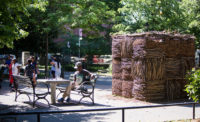Hammer Museum Unveils Heatherwick Studio Retrospective and New Michael Maltzan Bridge

Hammer Museum Unveils Heatherwick Studio Retrospective and New Michael Maltzan Bridge
Heatherwick Studio's U.K. Pavilion
Photo © Iwan Baan

Hammer Museum Unveils Heatherwick Studio Retrospective and New Michael Maltzan Bridge
Spun Chairs
Photo © Susan Smart

Hammer Museum Unveils Heatherwick Studio Retrospective and New Michael Maltzan Bridge
East Beach Café
Photo © Andy Stagg

Hammer Museum Unveils Heatherwick Studio Retrospective and New Michael Maltzan Bridge
Rolling Bridge
Photo © Steve Speller

Hammer Museum Unveils Heatherwick Studio Retrospective and New Michael Maltzan Bridge
New London Bus
Photo © Iwan Baan

Hammer Museum Unveils Heatherwick Studio Retrospective and New Michael Maltzan Bridge
Al Fayah Park Oasis
Image courtesy Heatherwick Studio

Hammer Museum Unveils Heatherwick Studio Retrospective and New Michael Maltzan Bridge
Learning Hub
Photo © Edmund Sumner

Hammer Museum Unveils Heatherwick Studio Retrospective and New Michael Maltzan Bridge
Learning Hub
Image courtesy Heatherwick Studio

Hammer Museum Unveils Heatherwick Studio Retrospective and New Michael Maltzan Bridge
Zeitz MOCAA
Image courtesy Heatherwick Studio

Hammer Museum Unveils Heatherwick Studio Retrospective and New Michael Maltzan Bridge
Garden Bridge
Image courtesy Arup










Just in time for Chinese New Year, the Hammer Museum made two resolutions of sorts, unveiling an architectural addition, and a traveling exhibition.
Thursday, the Los Angeles museum inaugurated the John V. Tunney Bridge, a sweeping steel and concrete pedestrian bridge by local architect Michael Maltzan that stitches together the museum’s second floor east and west galleries. (Guy Nordenson and Associates was the structural design engineer for the bridge and engineer of record was John A. Martin & Associates.)
The structure forms a dramatic backdrop to an equally thrilling survey exhibition chronicling the work of London-based design and architecture firm Heatherwick Studio. Organized by the Nasher Sculpture Center in Dallas and curated by Brooke Hodge, deputy director of Cooper Hewitt, Smithsonian Design Museum Provocations: The Architecture and Design of Heatherwick Studio dares viewers to let logic guide them to creative solutions to even the most pedestrian of problems.
“An inventor doesn’t have a style,” said principal Thomas Heatherwick at the opening, “but he’s always trying to find the right idea for something.”
Forty-two projects both built and unbuilt are presented within a compact space in Gallery 1 of the Hammer’s west wing, accessible from Maltzan’s bridge. Each wall is filled with overlapping canvases showcasing the diversity of work by the 20-year old studio—from the 2012 redesign of London’s double decker bus, which revived the much-loved Routemaster style of buses while providing commuters with a more accessible, environmentally-friendly transportation option, to the design of Longchamp’s leather Zip Bag, which transforms from a small bag into a day bag with zippers, in 2004.
Within the exhibition, Heatherwick’s projects are contextualized within a question, the answers to which leads to the innovative solutions the studio has become known for: How can a building represent a nation? (The UK Pavilion for the 2010 World Expo in Shanghai) How can a seaside building relate to the sea? (East Beach Café in West Sussex, UK, 2007) How do you turn a paper mill into a gin distillery? (Bombay Sapphire Distillery in Laverstoke, UK, 2014).
Vitrines in the center of the gallery display projects in various states of progress. “We tried to illuminate the creative process of the studio,” said exhibition curator Brooke Hodge, the deputy director of the Cooper Hewitt design museum. Finished pieces are displayed, and so are prototypes, early experiments, and soon-to-be realized work. For example, the UK Seed Pavilion at the 2010 World Expo, a sea urchin-like structure made from fiber optic rods embedded with plant seeds, is shown as a scale model along with actual sample rods. Above it hovers a full-scale cross-section of one rod embedded in its final waterproofing mechanism.
The exhibition makes clear that while the studio produces objects of wonder, the work is deeply embedded in pragmatism. Beneath Maltzan’s hourglass-shaped bridge, which cinches to nine feet at its center, visitors totter on Heatherwick’s playful rotation-molded spun chairs in the courtyard. Said Hammer museum director Ann Philbin, “I have yet to see it empty.”
Provocations: The Architecture and Design of Heatherwick Studio is on view at the Hammer Museum in Los Angeles until May 24, 2015. It travels to the Cooper Hewitt, Smithsonian Design Museum in New York from June 21 to October 25.












